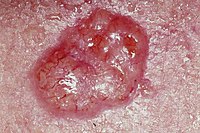
Photo from wikipedia
Introduction To assess the therapeutic potential of non-TBI conditioning and T-cell depleted (TCD) allo HCT for high risk malignancies, we conducted a prospective trial comparing: A. our standard 1375 cGy… Click to show full abstract
Introduction To assess the therapeutic potential of non-TBI conditioning and T-cell depleted (TCD) allo HCT for high risk malignancies, we conducted a prospective trial comparing: A. our standard 1375 cGy HFTBI + Thiotepa, 5mg/kg/dx2 + cyclophosphamide, 60mg/kg/dx2 vs B. Busulfex, 0.8mg/kg/6hx12(PK adjusted) + Melphalan 70mg/kg/dx2 + Fludarabine 25mg/m2/dx5 vs C. Clofarabine 20mg/m2/dx5 + Melphalan 70mg/m2/dx2 + Thiotepa 5mg/kg/dx2 as preparation for T-cell depleted CD34+ PBSC allografts isolated by the CliniMACS system. All pts received Thymoglobulin pre-transplant to prevent infection. No GVHD prophylaxis was given post transplant. Pts were stratified to arms A, B or C based on disease stage and clinical factors enhancing TBI risks (e.g. age >60m prior therapy or comorbidities), with Arm B the non-TBI arm used for myeloid malignancies and Arm C for lymphoid malignancies. Results From 5/13/10 to 12/31/16, 283 consenting patients were transplanted (106 in Arm A, 144 in B, 33 in C). All pts engrafted by day 10-11; 3 pts in Arm B and 1 in C had late graft failure with sustained T-cell chimerism. The 3 in Arm B reconstituted after TCD PBSC boost alone (N=2) or after CTX/ATG (N=1) conditioning. Cumulative Incidence (C.I.) of Acute Grade 3-4 GVHD was higher in Arm A (12%) than in B (4.2%) or C (3.0%) (p = 0.03), as was C. GVHD (Arm A 8.5%; B (1.5% p = 0.02); C (3%)). CI of relapse at 3 yrs was similar in all arms (A=28%; B=21%; C15%) (p = 0.22). Although pts in Arm B were older (med. 58.5 yrs) than in A (32 yrs) or C(32 yrs), NRM at 3 yrs for Arm B (16%) and A (14.8) were similar. However, NRM in Arm C (32.7%) was higher (p = 0.09). Because the median age of patients in Arm B (58.5 yrs) differed significantly from Arms A (31.9 yrs) and C (32.3 yrs); we evaluated DFS for each arm in 20 year cohorts of increasing age (Fig 1 A,B,C). Because of low cohort size, pts in Arm C aged 20-40) and 54% (Age 40-60). In Arm B, 5 year DFS for pts ≤ 20 was 69.3% and 85.7% for those >20-40, 48.6% for those >40-60 and 46.8% for those 60+ respectively (p = 0.02). In Arm C, 5 year DFS for pts ≤40 was 65% and for those >40, 30.7% (p = 0.01). Conclusion These results demonstrate that these chemotherapy-based regimens secure engraftment and hematopoietic reconstitution and similarly low rates of GVHD and relapse. They also suggest an advantage for patients ≤40 treated on Arm B. In >40-60yo patients, DFS for Arm B is equivalent to Arm A and also yields favorable results in older pts (>60-73 yrs). However, while patients ≤40 yrs of age fared well on Arm C, older patients were less likely to achieve extended OS and DFS than those on Arms A or B, likely as a consequence of increased TRM.
Journal Title: Biology of Blood and Marrow Transplantation
Year Published: 2020
Link to full text (if available)
Share on Social Media: Sign Up to like & get
recommendations!